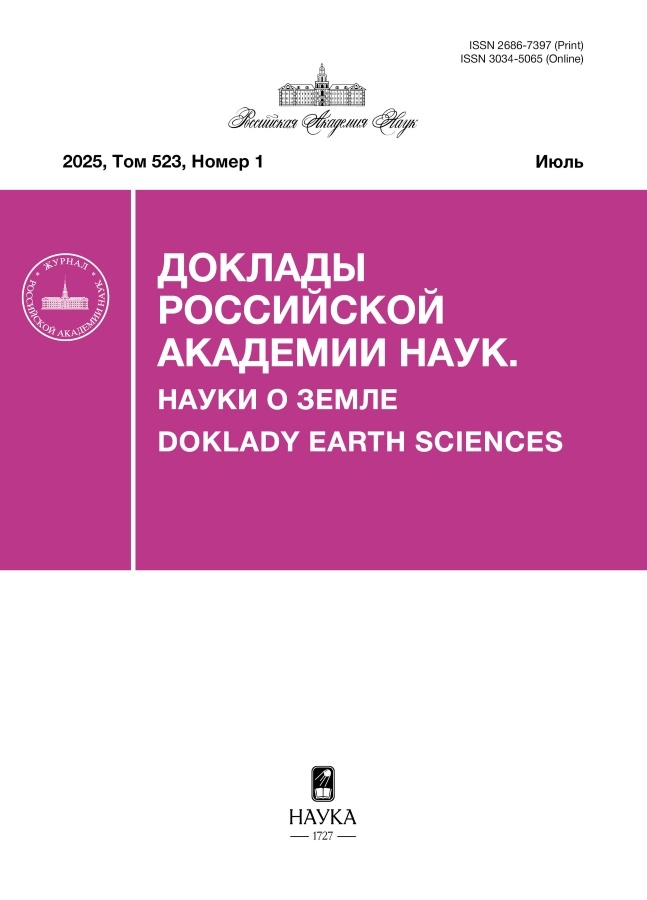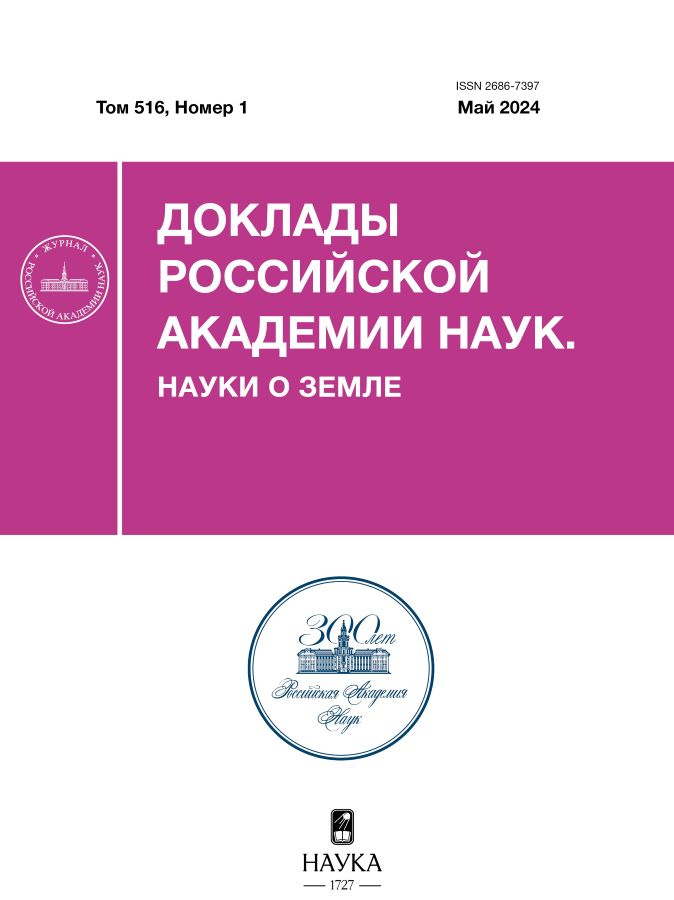Изотопный U‒Pb-возраст циркона (метод LA-ICP-MS) из магматических пород W‒Мо(‒Cu‒Au)-месторождения Чорух-Дайрон (Таджикистан): первые свидетельства постколлизионного рудообразования в Кураминском сегменте срединного Тянь-Шаня
- Авторы: Соловьев С.Г.1, Кряжев С.Г.2, Семенова Д.В.3, Калинин Ю.А.3, Бортников Н.С.1
-
Учреждения:
- Институт геологии рудных месторождений, петрографии, минералогии и геохимии Российской Академии наук
- Центральный научно-исследовательский геологоразведочный институт цветных и благородных металлов
- Институт геологии и минералогии им. В.С. Соболева Сибирского отделения Российской Академии наук
- Выпуск: Том 516, № 1 (2024)
- Страницы: 370-381
- Раздел: ГЕОЛОГИЯ РУДНЫХ МЕСТОРОЖДЕНИЙ
- Статья получена: 31.01.2025
- Статья опубликована: 18.12.2024
- URL: https://edgccjournal.org/2686-7397/article/view/650063
- DOI: https://doi.org/10.31857/S2686739724050071
- ID: 650063
Цитировать
Полный текст
Аннотация
В статье приведены данные изотопного U–Pb-датирования (метод LA-ICP-MS) циркона в главных типах высококалиевых магматических пород скарнового W–Mo(–Cu–Au)-месторождения Чорух-Дайрон, расположенного в Кураминском сегменте Срединного Тянь-Шаня вблизи крупнейших порфировых Cu–Mo–Au-месторождений Алмалыкского рудного района. Наряду с другими месторождениями золота, вольфрама, молибдена и меди, все эти месторождения входят в состав протяжённого позднепалеозойского металлогенического пояса Тянь-Шаня. Полученные конкордантные значения изотопного U–Pb-возраста циркона для пород последовательных интрузивных фаз Чорух-Дайронского плутона охватывают интервал от 298 млн лет до 290 млн лет. Это интервал включал кристаллизацию монцодиоритов (295.1±3.3 млн лет), кварцевых сиенитов (294.7±2.3 млн лет), кварцевых монцонитов (294.1±2.1 млн лет) и монцогранитов (293.0±3.0 млн лет). Полученные датировки циркона отвечают становлению плутона на границе позднего карбона‒начале ранней перми и подчёркивают его более молодой возраст по сравнению с продуктивными высококалиевыми интрузиями порфировых Cu–Mo–Au-месторождений Алмалыкского рудного района, относимыми к позднему карбону (порядка 337–313 млн лет и фрагментарно до 308–297 млн лет). В отличие от последних, внедрявшихся в обстановке субдукции, становление высококалиевых пород Чорух-Дайронского плутона отвечало переходной субдукционной-постколлизионной или даже, собственно, постколлизионной обстановке. Это позволяет различать два пульса рудоносного каменноугольного-пермского магматизма высококалиевой известково-щелочной и шошонитовой серий в Срединном Тянь-Шане. Таким образом, в регионе намечается металлогеническая эволюция, выраженная в переходе от порфировых Cu–Mo–Au-месторождений, связанных с субдукционным калиевым магматизмом и, по-видимому, сменяемых эпитермальными Au–Ag-месторождениями, к существенно вольфрамовым W–Mo–Cu–Au-месторождениям, связанным с более молодым калиевым магматизмом, проявленным скорее в постколлизионных условиях.
Полный текст
Об авторах
С. Г. Соловьев
Институт геологии рудных месторождений, петрографии, минералогии и геохимии Российской Академии наук
Автор, ответственный за переписку.
Email: serguei07@mail.ru
Россия, Москва
С. Г. Кряжев
Центральный научно-исследовательский геологоразведочный институт цветных и благородных металлов
Email: serguei07@mail.ru
Россия, Москва
Д. В. Семенова
Институт геологии и минералогии им. В.С. Соболева Сибирского отделения Российской Академии наук
Email: serguei07@mail.ru
Россия, Новосибирск
Ю. А. Калинин
Институт геологии и минералогии им. В.С. Соболева Сибирского отделения Российской Академии наук
Email: serguei07@mail.ru
Россия, Новосибирск
Н. С. Бортников
Институт геологии рудных месторождений, петрографии, минералогии и геохимии Российской Академии наук
Email: serguei07@mail.ru
Academician of the RAS
Россия, МоскваСписок литературы
- Kudrin V. S., Soloviev S. G., Stavinsky V. A., Kabardin L. L. The gold-copper-molybdenum-tungsten ore belt of the Tien Shan // Internat. Geol. Rev. 1990. V. 32. P. 930–941.
- Yakubchuk A., Cole A., Seltmann R., Shatov V. Tectonic setting, characteristics and regional exploration criteria for gold mineralization in central Eurasia: the southern Tien Shan province as a key example / Goldfarb R., Nielsen R. (Eds.) // Integrated Methods for Discovery: Global Exploration in Twenty-First Century. Economic Geology Special Publication. 2002. V. 9. P. 77–201.
- Cheng Z., Zhang Z., Chai F., Hou T., Santosh M., Turesebekov A., Nurtaev B. S. Carboniferous porphyry Cu-Au deposits in the Almalyk orefield, Uzbekistan: the Sarycheku and Kalmakyr examples // International Geology Review. 2017. V. 60. P. 1–20.
- Zhao X.-B., Xue C.-J., Chi G.-X., Mo X.-X., Nurtaev B., Zhang G.-Z. Zircon and molybdenite geochronology and geochemistry of the Kalmakyr porphyry Cu–Au deposit, Almalyk district, Uzbekistan: Implications for mineralization processes // Ore Geol. Rev. 2017. V. 86. P. 807–824.
- Soloviev S. G., Kryazhev S. G. Geology, mineralization, and fluid inclusion characteristics of the Chorukh-Dairon W-Mo-Cu skarn deposit in the Middle Tien Shan, Northern Tajikistan // Ore Geol. Rev. 2017. V. 80. P. 79–102.
- Seltmann R., Konopelko D., Biske G., Divaev F., Sergeev S. Hercynian post-collisional magmatism in the context of Paleozoic magmatic evolution of the Tien Shan orogenic belt // Journal of Asian Earth Sciences. 2011. V. 42. P. 821–838.
- Seltmann R., Porter T. M., Pirajno F. Geodynamics and metallogeny of the central Eurasian porphyry and related epithermal mineral systems: a review // Journal of Asian Earth Sciences. 2014. V. 79. P. 810–841.
- Власова Д. К., Жариков В. А. Контактово-инфильтрационные скарны Чорух-Дайрона / Ред. Коржинский Д. С., Жариков В. А. Метасоматизм и оруденение. Москва, изд-во Наука. 1975. С. 5–80.
- Soloviev S. G., Krivoschekov N. N. Petrochemistry of rocks in the Chorukh-Dairon monzonite-syenite-granite pluton, Northern Tajikistan // Geochem. Internat. 2011. V. 49. P. 691–710.
- Мамаджанов Ю. Петрология и геохимия шошонит-латитовой ассоциации Кураминской зоны. Автореферат дисс. канд. геол.-мин. наук. Душанбе: Институт геологии Таджикистана. 1995. 24 с.
- Волков В. Н., Аракелянц М. М., Таджибаев Г. Т. Возраст магматических и метасоматических пород Чорух-Дайронского грабена по данным калий-аргонового датирования (Срединный Тянь-Шань) // Доклады Таджикской АССР. Серия геологическая. 1990. Т. 12. С. 40–47.
- Griffin W. L., Powell W. J., Pearson N. J., O’Reilly S. Y. GLITTER: Data reduction software for laser ablation ICP-MS / Sylvester P. (Ed.). // Miner. Assoc. of Canada. Short Course Series. 2008. V. 40. P. 307–311.
- Hiess J., Condon D.J., McLean N., Noble S. R. 238U/235U systematics in terrestrial uranium-bearing minerals // Science. 2012. V. 335. P. 1610–1614.
- Slama J., Kosler J., Condon D. J., et al. Plesovice zircon – a new natural reference material for U-Pb and Hf isotopic microanalysis // Chemical Geology. 2008. V. 249. № 1–2. P. 1–35.
- Ludwig K. User’s Manual for Isoplot 3.00 // Berkeley Geochronology Center. Berkeley, CA, 2003. P. 1–70
- Black L. P., Kamo S. L., Allen C. M. et al. Improved 206Pb/238U microprobe geochronology by the monitoring of a trace-element-related matrix effect; SHRIMP, ID-TIMS, ELA-ICP-MS and oxygen isotope documentation for a series of zircon standards // Chemical Geology. 2004. V. 205. P. 115–140.
- Miller J. S., Matzel J. E., Miller C. F., Burgess S. D., Miller R. B. Zircon growth and recycling during the assembly of large, composite arc plutons // J. Volcanol. Geotherm. Res. 2007. V. 167. № 1/4. P. 282–299.
- Sisson V. B., Pavlis T. L., Roeske S. M., Thorkelson D. J. Introduction: An overview of ridge-trench interactions in modern and ancient settings / In: Sisson, V. B., Roeske, S. M., and Pavlis, T. L. (eds.). // Geology of a transpressional orogen developed during ridge-trench interaction along the North Pacific margin. Geological Society of America Special Paper. 2003. V. 371. P. 1–18.
- Pearce J. A., Peate D. W. Tectonic implications of the composition of volcanic arc magmas // Annual Rev. Earth Planet. Sci. 1995. V. 23. P. 251–285.
- Lustrino M., Wilson M. The circum-Mediterranean anorogenic Cenozoic igneous province // Earth-Science Reviews. 2007. V. 81. P. 1–65.
Дополнительные файлы















